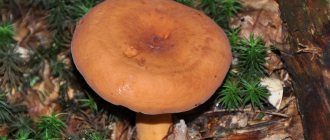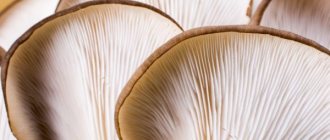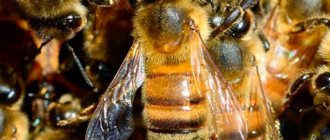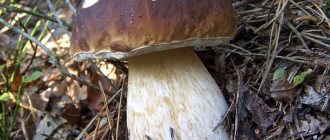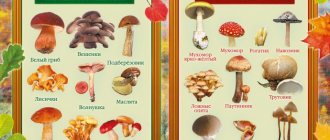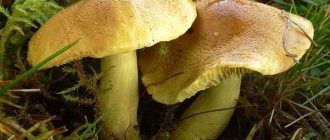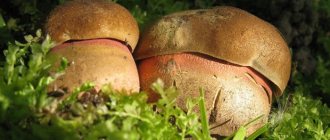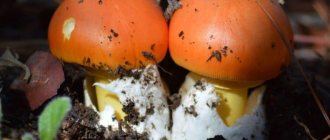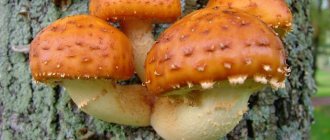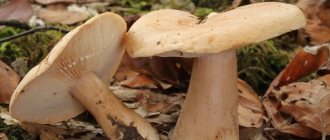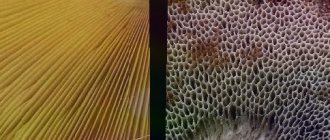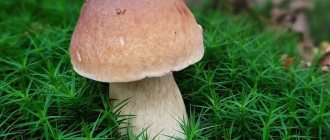Obabok and boletus - are they the same thing or not?
According to the classification, boletus mushrooms are indeed little birds; they are part of the genus with that name. But at the same time, not every mushroom is an ordinary boletus, because other types of mushrooms are also called by this word.
In particular, the obobkaks include:
- boletus - gray, or hornbeam, harsh, marshy, black, pinkish and multi-colored;
- boletus - black-scaled, red, white, yellow-brown;
- redheads - spruce, pine and oak;
- Far Eastern and blackening obobki.
All these mushrooms belong to the edible or conditionally edible categories, have similar structural features, but can differ greatly in color.
Varieties
boletus
The old guy has a poisonous double
The fruiting period of boletus begins at the end of May and continues until the last days of October.
Edible varieties:
- Common boletus, or birch cap, or blackhead: cap with a diameter of 5-15 cm, color from gray to brown-brown, varies depending on the weather, mushroom pulp is dense, but at the same time watery, grows in birch and mixed forests, fruiting period – end of May – October.
- Gray boletus, or hornbeam: a cap with a diameter of 6-20 cm, the color is brown-gray, the mushroom pulp is cotton-like, acquires a purple hue when cut, grows in deciduous forest belts from July to September.
- Black boletus: cap with a diameter of 5-20 cm, black-brown color, mushroom pulp is dense, elastic, with a sweetish taste, grows in wetlands (edges of raised bogs) in forests with birch, fruiting period - July-September.
- Boletus pinkish: cap with a diameter of 8-18 cm, color brownish-gray, mushroom pulp is fibrous, changes color to pinkish when cut, grows in damp birch forests and pine-birch forest belts; fruiting period is July-October.
- White boletus, or marsh boletus: cap diameter 4-15 cm, color off-white, mushroom pulp is watery, the white color often does not change when cut, but sometimes turns blue, the taste is insipid, the smell is weak, grows in birch forests and mixed forests nearby swamps, fruiting period - second half of July-October.
The edible boletus (boletus) has a false counterpart called the gall mushroom and is distinguished by the pronounced bitterness inherent in the pulp.
Boletus
Mushroom appearance time:
- in the last days of June, but the harvest is not abundant, such mushrooms are called spikelets;
- in mid-July, stubble trees grow en masse;
- from the end of August to the end of September, deciduous plants appear in large numbers.
During the wet summer season, between the growth stages of boletuses, single fruiting is observed.
Commonly found edible varieties:
- Red boletus, or redhead: a cap with a diameter of 5-20 cm, the color depends on the place of growth: in poplar forests it has a gray tint, in aspen forests it is dark red, in mixed forests it is orange-red. The fruiting period is from June to October.
- White boletus: a cap with a diameter of 4-20 cm, the color is light brown, the mushroom pulp is hard, turns blue when cut, grows in aspen and mixed forests, the fruiting period is June-September. By the way. White boletus is a rather rare mushroom. It is included in the Red Book of Russia. This species is often considered a variety of aspen boletus (yellow-brown).
- Boletus boletus: cap with a diameter of 8-20 cm, red-brown color. The pulp is dense, turns black when cut, grows in dry places among mosses, fruiting period is June-September.
Irina Selyutina (Biologist):
On a young aspen boletus, the cap tightly fits the upper part of the leg - it actually squeezes, reminiscent of a thimble placed on a finger. But as it grows, the cap evens out and in mature specimens has the shape that is familiar to us. But overgrown specimens are characterized by an almost flat shape.
Very often, beginning mushroom pickers confuse boletus and aspen mushrooms. To prevent this from happening, make a small cut on the fruiting body of the mushroom: if the initially white flesh turns blue and then turns black, you have a boletus in front of you.
Since the species of boletus and boletus differ little from each other in appearance, mushroom pickers generally call them obabki. But each species has its own specific characteristics and experienced mushroom pickers know this. Knowledge of the so-called can especially help. ecological characteristics of the species, which will always allow you to bring home a basket full of wonderful edible mushrooms.
Boletus mushrooms have a false conditionally edible counterpart called bitterling, also known as gall mushroom, which contains a characteristic bitterness.
Where do babies grow?
The boletus and aspen boletuses, which belong to the genus of boletuses, choose mainly deciduous forests or mixed plantings for their growth. They are found everywhere in regions with a temperate climate, and are also found in subtropical and northern regions.
A distinctive feature of the genus is the desire to form a symbiosis with the roots of deciduous trees. Boletus and aspen boletuses are not found in open spaces; they settle directly under the trunks of aspens, birches, oaks, beeches, hornbeams and other trees.
How to fry obabki with potatoes?
One of the most delicious dishes that can be prepared with mushrooms is fried potatoes with mushrooms. Before frying, as in any other dish, mushrooms should be peeled and boiled.
- At the beginning of cooking, potatoes cut into large cubes are fried.
- At this time, in another frying pan, fry the onion pieces until golden brown and add mushrooms to it.
- After the liquid has evaporated, add spices and salt to the mushrooms and leave them on the fire for another five minutes.
- Before serving, mix the prepared potatoes with mushrooms.
Obabki are one of the most common mushrooms that can be found in every region of Russia. They have a distinct taste and are widely used in cooking. Housewives should not be afraid of experiments in the kitchen - a dish with obabka in any case will turn out to be tasty and can surprise the household.
What does a dog look like?
The photo of the obtuses shows that, depending on the specific variety, they may differ in appearance. However, a general description can be given to this genus of mushrooms.
The caps of the little ones are quite large, on average 10-15 cm in diameter, most often of a hemispherical convex shape, but sometimes also spread out. The surface of the caps can be felt, velvety or smooth, but they are not characterized by shine; usually their skin is matte.
Caps belong to the category of tubular mushrooms, so the underside of their caps is porous and easily separated. The tubes themselves are yellowish, grayish or almost white in color, with small pores. In young mushrooms, the tubular layer is lighter; with age, the shade becomes darker.
Obabkas are characterized by a cylindrical high leg up to 10 cm and higher. There is usually a slight thickening below, the surface of the leg is fibrous or scaly, for example, like in boletus mushrooms.
If you break or cut the egg, its flesh will be white, but upon contact with air it will quickly change color to dark blue, black or reddish. After cooking and subsequent culinary processing, the mushrooms turn black; this is completely normal for these mushrooms.
How to marinate obabki?
Obabok is a valuable edible mushroom. It is universal and suitable for salting, pickling, drying and freezing, but marinated boletus mushrooms are especially good.
There are many pickling recipes, but in most cases they differ from each other only in the set of ingredients, and the cooking technology itself remains the same. Pay attention to the classic step-by-step recipe for pickled obabki for the winter.
Ingredients
To prepare a tasty preparation, you can take either one type of mushroom or boletus with boletus, mixed in equal proportions. The recipe is designed for 1 kg of fruiting bodies.
You will need:
- 1 medium onion;
- liter of purified water;
- 2 peas of allspice;
- 2 clove inflorescences;
- 2 bay leaves;
- 100 ml vinegar (6%);
- 20 grams of salt and sugar.
To make the preparation more aromatic, you can also add a pinch of cinnamon, but this component is optional.
Recipe
Before cooking, mushrooms must be cleared of debris and rinsed under running water. Small specimens are left whole, while large ones are cut into pieces of arbitrary size. Next, the product is poured with water and soaked for several hours.
Preparation step by step:
- First, the obabki is boiled in clean water for 10 minutes. Then the liquid is decanted and the mushrooms are poured again, but this time the water should be salted and the cooking time should be 20 minutes. During the process, foam will form on the surface, which must be removed.
- Place the finished mushrooms in a colander and let them drain. Meanwhile, prepare the marinade.
- First add salt and sugar to boiling water, then the remaining spices. Pour the mushrooms into the boiling marinade gradually, and then cook for half an hour. 10 minutes before the end of cooking, pour out the vinegar.
When the mushrooms are cooked, they are placed in sterilized jars along with the marinade. The containers are covered with plastic lids and stored in the refrigerator or cellar.
Why is it called that?
The unusual name of the genus arouses interest - at first glance it seems completely incomprehensible. The word is deciphered quite simply - in some Russian regions, for example, near Pskov, Novgorod and Arkhangelsk, the dialect word “baba” is used to describe stumps and fallen trees.
If “baba” is a stump, then, accordingly, “baba” are mushrooms growing not far from the stump, around it. It is curious that this word is used only for boletus and aspen mushrooms, although the location near trees is also typical for many other mushrooms, for example, honey mushrooms.
Harm and contraindications
Very frequent consumption of mushroom dishes is not recommended due to slow absorption. Those who suffer from stomach and duodenal ulcers, gastritis, hepatitis, and inflammation of the gallbladder should not eat boletus dishes.
Mushrooms are contraindicated in case of allergies and intolerance to the product, with low activity of gastrointestinal enzymes, and with digestive problems. It is not recommended to give mushroom dishes to preschool children and pregnant women.
Is it possible to eat bastards?
Mushrooms from the genus obabok are completely suitable for food use. Moreover, they belong to the delicacy category; collecting a full basket of boletus and boletus is considered a great success. Minimal processing is required, there is no need to soak the fruiting bodies for a long time, and the taste of the mushrooms is very pleasant and mild.
Obabki are suitable for any culinary processing. Most often they are boiled, pickled and fried, and delicious mushrooms can also be dried. Dried boletus and boletus can be stored for a very long time, and they are most often used to add to soups and other hot dishes.
Important! It is not the caps that are most loved by gourmets, but the stems of the fruiting bodies. Unlike caps, they retain their dense structure well after heat treatment and remain strong and pleasant.
Soup with ducks
One of the traditional recipes is also boletus soup. Before cooking, mushrooms must also go through the first two stages of processing. After this, you can begin to “collect” the soup.
- to begin with, seasonings and diced potatoes are added to the boletus and aspen mushrooms;
- after this, carrots and onions are fried into the soup;
- then add garlic or bay leaf to taste;
- On average, the soup takes from 20 to 40 minutes to prepare; a sure sign that the dish is ready is that the potatoes will become soft.
False little jokes
The appearance of the mushrooms is quite expressive; these mushrooms are difficult to confuse with other edible or even more so poisonous mushrooms. However, the possibility of error still exists, especially for inexperienced foragers just starting to study edible mushrooms.
Bile mushroom
Most of all, in appearance, the boletus resembles bitterweed; it is also called gall mushroom or false boletus. It is similar to edible mushrooms in size and structural features. In particular, the false double has a large convex cap in the shape of a hemisphere, a brown-brown or gray-brown skin color, and a tubular lower surface of the cap. The gall mushroom also grows on a strong cylindrical stalk of a light color.
The main difference between bittergrass, which allows it to be distinguished from bitterling, is the pattern on the stalk, a little reminiscent of blood vessels. In boletus and boletus, the leg is covered with scales and looks completely different.
Another distinctive characteristic of the gall fungus is its sharp bitter taste, which cannot be confused with the taste of edible mushroom. Moreover, after boiling and subsequent heat treatment, the bitterness does not disappear, but even intensifies. But in order to check this difference, you would have to taste the mustard, and this is not recommended; it is better to focus on external signs.
The gall mushroom does not have poisonous properties, and accidental consumption does not cause significant harm to health. But the taste of the mushroom is too pungent, so any dish that contains bitter bitter will be hopelessly spoiled.
Advice! If the mushroom is old, then you can also recognize it as a mustard by its pulp, untouched by insects; the cap and stem are so bitter that even worms and forest flies do not use them as food.
Death cap
In the absence of experience, the edible toadstool can be confused with the most poisonous and dangerous mushroom in Russia - the pale toadstool. Its leg can also be cylindrical and quite dense; the toadstool and toadstool are similar in size and shape of the cap. The skin of the toadstool is often yellowish-brown, almost the same as that of boletus and boletus. In addition, this poisonous mushroom very often grows under aspen, beech and birch trees, exactly where mushroom pickers expect to find edible mushrooms.
But the differences between species are very noticeable. The pale grebe is characterized by:
- plates on the lower surface of the cap, while caps are tubular mushrooms;
- absence of characteristic scales on the leg - the toadstool's leg is smooth and even, sometimes it has a moire pattern;
- a peculiar thickening at the base of the stem, it looks like a separate part of the fruiting body, and is not at all similar to the thickening in boletuses and boletuses.
But the famous ring on the leg of the pale grebe is not always found. The ring represents fragments of the covering of the fruiting body and is usually present in young mushrooms, but most often disappears with age. Therefore, it is worth focusing on those signs and differences that persist throughout the entire life cycle.
False species and doubles
Tubular mushrooms do not have such dangerous doubles as lamellar mushrooms. And yet, due to inexperience, the very poisonous pale grebe can be mistaken for a swamp boletus, and the real and pinkish species can be confused with a gall fungus.
Death cap
Death cap
In various deciduous forests - under birches, aspens, beeches, this most poisonous mushroom is found from July to October. The cap is first spherical, then flattened, glossy, light, sometimes with a greenish or olive tint, reaches a diameter of 10 cm. The leg is slender, without scales, with a cuff under the cap, the expanded base is hidden in a kind of pouch near the ground.
The whitish pulp is aromatic, fragile, and tastes sweet. Unlike tubular mushrooms, wide white plates are found under the cap. The species is very poisonous and even a small amount causes severe poisoning, and there is no antidote.
Bile mushroom
Bile mushroom
This species is not poisonous, but is not eaten due to its unpleasant, bitter, acrid taste. The cap is hemispherical, up to 15 cm in diameter. The skin is glossy, brownish or light chestnut. The leg is squat, thickened in the middle, with a dark mesh pattern at the top.
The pulp is very bitter, white, and turns pink when cut, reminiscent of pink boletus. In the latter, the tubular layer is creamy and turns pink only when pressed or at a break, while in the gall fungus the tubes are initially bright pink. Found in coniferous and coniferous-deciduous forests from mid-summer until frost.
Taste qualities of mushrooms
Boletus and boletus fall into the category of noble or delicious mushrooms. According to gourmet reviews, their taste is second only to porcini mushrooms. Obabki can be a good addition to almost any dish.
At the same time, opinions about the taste of the caps and legs of the caps differ sharply. Mushroom pickers prefer to eat the strong, hard and elastic legs of fruiting bodies. But the caps are much less popular because they become very boiled and acquire an unpleasant, overly soft consistency.
How to cook properly
Boletuses and boletuses are tasty and healthy in any form. They can be fried, boiled, stewed, baked and pickled. For the winter, these mushrooms are often dried and frozen.
Preliminary preparation
Obabki are also loved by mushroom pickers for the reason that they do not require painstaking cleaning.
They are quite large and clean on their own (there is no need to remove the film from them, as for example with butter, soak or cut off the legs).
If necessary, only cut off the base of the mushroom and remove damaged areas. A large specimen is cut into several parts to make it easier to cook or dry.
The wormy parts of the shoots should be immediately cut off and thrown away, since the worms quickly spread to healthy fruiting bodies.
Before cooking, boletus and aspen mushrooms are thoroughly washed with water. Before drying, it is better not to wash them, but to wipe them with a slightly damp cloth, after removing any stuck leaves or twigs.
Some mushroom pickers prefer not to wet the mushrooms at all before drying.
Mushrooms, boletus, mushrooms.
A unique meeting on one table. A genus of little dogs. Various representatives of the genus Leccinum.
Jahmal[TGK], Dj Puza TGK – OBAKI
Cooking rules
- Before cooking (frying, stewing, baking), the obabki must be boiled. When the water boils, you need to pour it out and replace it with a new one - cold, and cook for about an hour, periodically removing the foam. If mushrooms are boiled for soup, the first broth is also drained.
():
When boiling mushrooms:
- the volume of water should be 2 times greater than the volume of mushrooms;
- For 1 kg of mushrooms take 1 tbsp. salt;
- simmer;
- At the end of cooking, the finished mushrooms sink to the bottom.
Obabki do not have a strong taste, so they can be cooked with other mushrooms.
- Harvesting frozen boletus and boletus requires almost no effort. They must be cut, thoroughly washed and dried, and then placed in a bag or container. Some housewives prefer to boil the obabki before freezing. After this, they must be placed in a colander and allowed to drain excess liquid.
- You can dry mushrooms in the oven if you don’t have a special device. The pieces are laid out on baking sheets and left at a temperature of 50-60°C with the door slightly open. Stir every half hour.
- Before frying, the fruiting bodies are not boiled for very long - about half an hour, but then they are thoroughly fried (about the same amount of time). During the cooking process, potatoes, onions, meat or sour cream are added to them.
Benefits and harm to the body
In cooking, obabki are valued not only for their pleasant taste. Mushrooms of this genus have a beneficial effect on the body, since they contain many useful compounds. Mushroom pulp contains:
- vitamins - B1 and B2, PP;
- vitamins E and D;
- ascorbic acid and thiamine;
- potassium and iron;
- magnesium and phosphorus;
- manganese and calcium;
- amino acids - arginine, glutamine and leucine;
- cellulose;
- a huge amount of vegetable protein.
The beneficial effect of boletus on the body is expressed in the fact that boletus and aspen boletus:
- help improve blood composition and build muscle mass;
- improve metabolism and help the body get rid of toxins;
- balance blood sugar levels and remove toxins;
- normalize the functioning of the liver and kidneys;
- compensate for the lack of vitamins and mineral salts;
- stimulate the immune system and strengthen resistance to diseases.
However, if used carelessly, mushrooms can exhibit their harmful qualities. First of all, it is not recommended to use them if you have an individual intolerance, in which case even a small amount of mushroom pulp will lead to poisoning.
It is also not recommended to eat obabki:
- with pancreatitis and ulcers in a state of exacerbation;
- with frequent constipation and sluggish digestion.
Attention! It is better not to offer mushrooms to children under 7 years of age, although mushrooms are completely harmless, they contain too much protein, and it will be difficult for a sensitive stomach to digest them.
Where, when and how does it grow
The fungus is common in birch and mixed deciduous forests; sometimes individual species can be found in pine forests. The mycelium grows well in sun-warmed soil, but the soil must be moist. The obabok mushroom does not grow in open places, preferring shaded places in symbiosis with birch. Selects for growth the edges of forest edges and country roads, paths, places near the trunks. Oblap does not like acidic peat bogs, preferring pH-neutral loams and calcareous soils.
- Swamp boletus grows in low-lying birch forests with moist soil, usually found in the form of seedlings. And in the Far Eastern region of Russia, the Far Eastern marsh boletus is widespread.
- The harsh subspecies prefers deciduous habitat (mainly aspen or poplar), mixed with coniferous forest species on calcareous soil.
- The variegated caps of the motley tomb are found on the edges and clearings of dense deciduous forests of poplar and birch.
- The pinkish oblap loves the edges of swamps and even peaty soils (but moist), and ripens in August-September. It is more common in forest-tundra and tundra among dwarf birches.
- The hornbeam or gray hornbeam lives in hornbeam forests and parks, in hazel groves, and near poplars. It is believed that it should be collected when the mountain ash blooms, after haymaking, in mid-autumn. It grows both in groups and individually.
Use
Since the taste of the delicious fruiting bodies is second only to porcini mushrooms, mushrooms are used truly everywhere in cooking. Boiled mushrooms are added to salads and snacks, birch and aspen mushrooms are fried and eaten with potatoes and meat, their legs and caps add an unusual and very pleasant taste to hot soups. Also, the fruiting bodies are often dried and pickled for the winter - you can enjoy the taste of the fruit even in the cold winter months.
Edible fruit bodies do not require special processing before cooking. There is no need to soak them, just clean the mushrooms from debris, remove the skin from the stem and cut off the tubular layer on the cap. After this, the raw materials are washed and immediately sent to boil in salted water for 30-40 minutes, and after the first 5 minutes of cooking, the water is drained and replaced with fresh water.
In addition to cooking, birch and aspen trees are used for medicinal purposes. They are suggested to be used in many folk health recipes. It is believed that infusions and tinctures of these mushrooms:
- have a beneficial effect on kidney health;
- help get rid of inflammatory diseases;
- have a good effect on diabetes;
- have a calming and relaxing effect.
Low-calorie fats can be found as part of weight loss diets. Due to their high protein content, aspen and birch trees fill you up well and help get rid of hunger. But it is impossible to gain weight on mushrooms if you eat properly, so for weight loss the effect will only be positive.
Beneficial features
Obabka contains proteins necessary for humans, including essential amino acids.
Contains valuable microelements:
- potassium;
- phosphorus;
- iron;
- calcium;
- magnesium.
In addition, these mushrooms are rich in vitamins (C, B, PP, E and others).
Thanks to the reserve of nutrients, they contribute to the health of the heart, musculoskeletal system, and nervous system.
Consumption of fatty acids increases immunity, normalizes metabolism, and also improves blood structure, vision, and complexion. The fibrous tissues of mushrooms have a beneficial effect on digestion.
Antioxidants are especially valuable in their composition - they slow down aging and counteract cancer tumors.
So, boletus or bolete?
The topic at the bus stop seemed to me not without meaning, but I did not intervene, since the arguers were already waving their arms wildly and getting personal. And it would be okay in academic circles, where scientific reputation may depend on such subtleties. But no - in a small Kuban village, where very few people are familiar with the word “mycology”. But it’s necessary! Well, we'll figure it out.
Actually, boletus is a boletus. Only the boletus is also a little boletus. There is such a genus in the Boletaceae family - Léccinum, or Obabok , which includes different types of boletus and boletus. That is, the boletus is definitely an aspen boletus, but the boletus is not necessarily a boletus, it can also be an aspen boletus.
But they argue about something else: about the thickness, density and color of the stem, about the smoothness, wrinkles or cracks of the cap. About the color of the cap and tubular layer, the degree of darkening of individual parts, as well as in which places both of them prefer to grow.
In fact, discussions are going on around different types of boletus. Including the hornbeam (Leccinum griseum), which is often found in our area, since the forest here is predominantly oak and hornbeam. So he is the main contender for the proud title of “babes”. He is a little boletus, of course, but at the same time he is a gray or elm boletus .
Young boletuses have caps that look like “domes” and become flatter as they grow. © Tatyana Nikolina
Main types
Common boletus (Leccinum scabrum)
Common boletus (Leccinum scabrum)
The best appearance of this group is characterized by a smooth hemispherical cap with a diameter of up to 15 cm. The skin is chestnut with a grayish, black or reddish tint; in young mushrooms it is light. The leg is up to 20 cm high, slender, wide at the base, the surface is dotted with a scaly dark pattern.
The pulp is grayish-white, then gray, does not darken when scrapped, first hard, then soft, porous. The structure is spongy in rainy weather. The taste is pleasant, the aroma is mushroom.
Swamp boletus (Leccinum holopus)
Swamp boletus (Leccinum holopus)
A tall mushroom with a very light, almost white convex cap up to 15 cm in diameter. The skin is thin, sometimes greenish or brown. The leg is long, thin, often curved, cap-colored or brownish. The tubes are whitish-cream, then brownish, turning green when pressed.
Morphological characteristics
All species united by the name “obobok” are characterized by the presence of the following common morphological characteristics:
- large size, hemispherical or prostrate cap;
- the surface of the cap is smooth, felt or velvety, matte;
- tubular type hymenophore of free type or notched type, quite easily separated from the cap;
- tubes of a whitish, gray or yellow color, with the presence of small and round pores that darken with aging;
- cylindrical leg with slight thickening downwards, with a scaly or fibrous surface;
- the flesh of the mushroom is white in color, changing when cut to reddish, dark blue-violet or black;
- During heat treatment, the pulp turns black.
The category of obabka includes more than twenty species, of which 15 species of edible obabok grow in the soil and climatic conditions of our country.
How to distinguish boletus from boletus?
Despite their eloquent names, these mushrooms, belonging to the same genus, can settle under aspens, and under birches, and under the canopy of many other trees.
Young mushrooms, especially light-colored species, are difficult to distinguish, and to more accurately determine the species, it is better to look for adult specimens. They are distinguished by the color of the skin, the structure and color of the pulp when broken.
In general the colors of boletus mushrooms are more modest, often in gray-brown or brown tones; boletus mushrooms are brighter - their caps are reddish-brown and orange-yellow. However, this difference is not always characteristic - the common boletus and the red boletus are similar in their chestnut-red caps, and both of these species can grow side by side.
An experienced mushroom picker will distinguish boletus by the structure of the pulp - it is more porous, loose, becomes watery with age and, when broken, does not darken or changes color slightly - often turning pink.
Boletuses are characterized by tight flesh, which quickly turns color when cut - turns blue, purple or brown. The fruiting bodies are hard and are not destroyed by heat treatment, and therefore these species are often preferable to boletus mushrooms.
Both mushrooms are edible, have excellent quality and can be safely eaten - they are suitable for drying, pickling and any culinary delights.
Excerpt characterizing Obabok
At this time, behind Kutuzov, the sounds of regiments greeting each other were heard in the distance, and these voices began to quickly approach along the entire length of the stretched line of advancing Russian columns. It was clear that the one they were greeting was traveling quickly. When the soldiers of the regiment in front of which Kutuzov stood shouted, he drove a little to the side and looked back with a wince. On the road from Pratzen, a squadron of multi-colored horsemen galloped along. Two of them galloped side by side ahead of the others. One was in a black uniform with a white plume on a red anglicized horse, the other in a white uniform on a black horse. These were two emperors with their retinue. Kutuzov, with the affectation of a soldier at the front, commanded the troops standing at attention and, saluting, drove up to the emperor. His whole figure and manner suddenly changed. He took on the appearance of a commanding, unreasoning person. With an affectation of respect that obviously struck Emperor Alexander unpleasantly, he rode up and saluted him. An unpleasant impression, just like the remnants of fog in a clear sky, ran across the emperor’s young and happy face and disappeared. He was, after ill health, somewhat thinner that day than on the Olmut field, where Bolkonsky saw him for the first time abroad; but the same charming combination of majesty and meekness was in his beautiful, gray eyes, and on his thin lips, the same possibility of varied expressions and the prevailing expression of complacent, innocent youth. At the Olmut show he was more majestic, here he was more cheerful and energetic. He became somewhat flushed after galloping these three miles, and, stopping his horse, sighed with repose and looked back at the faces of his retinue, just as young and as animated as his. Chartorizhsky and Novosiltsev, and Prince Bolkonsky, and Stroganov, and others, all richly dressed, cheerful, young people, on beautiful, well-groomed, fresh horses, talking and smiling, stopped behind the sovereign. Emperor Franz, a ruddy, long-faced young man, sat extremely straight on a beautiful black stallion and looked around him with concern and leisurely. He called one of his white adjutants and asked something. “That’s right, what time did they leave,” thought Prince Andrei, observing his old acquaintance, with a smile that he could not contain, remembering his audience. In the retinue of the emperors there were selected young orderlies, Russian and Austrian, guards and army regiments. Between them, beautiful spare royal horses were led by riders in embroidered blankets. It was as if, through the open window, the smell of fresh field air suddenly came into the stuffy room, so the gloomy Kutuzov headquarters smelled of youth, energy and confidence in success from these brilliant young people who had galloped up. - Why don’t you start, Mikhail Larionovich? - Emperor Alexander hastily turned to Kutuzov, at the same time looking courteously at Emperor Franz. “I’m waiting, Your Majesty,” answered Kutuzov, leaning forward respectfully. The Emperor lowered his ear, frowning slightly to indicate that he had not heard. “I’m waiting, your Majesty,” Kutuzov repeated (Prince Andrei noticed that Kutuzov’s upper lip trembled unnaturally while he was saying this, “I’m waiting”). “Not all the columns have assembled yet, Your Majesty.” The Emperor heard, but apparently did not like this answer; he shrugged his stooped shoulders and glanced at Novosiltsev, who stood nearby, as if with this glance he was complaining about Kutuzov.
Obabok Far Eastern
As the name suggests, the mushroom is widespread in the Far East, in the Primorsky Territory. Can be collected in August and September. The main distinctive feature of the species is that in the absence of rain for a long time, the mushroom cap cracks, forming furrows from the crown to the edge. Young mushrooms have a hemispherical cap with small wrinkles. The color of the cap film is from brown to brownish-red. There are cases when mushroom pickers found mushrooms with a cap with a diameter of 25 cm!
The stem of the mushroom is strong, long, and ocher in color. The flesh is off-white, turning pink when cut. Method of preparing Far Eastern obabok: frying, boiling and stewing using seasonings, since the taste and smell of the mushroom are weakly expressed.
INTERESTING: If you collect all the mushrooms at a young age on one part of the mycelium, without allowing them to ripen, then it will bear fruit all season (under suitable weather conditions).
Video about boletus mushrooms (boletus mushrooms)
Everyone was successful with boletus mushrooms - beautiful, nutritious, tasty mushrooms, famous for their productivity and long-term fruiting. A knowledgeable mushroom picker will never be left empty-handed and, after a mushroom rain, he will easily find the stout caps under birch, hornbeam or poplar trees, notice the sturdy ones peeking out from under the leaves in swampy lowlands and on the edges of light birch groves, and will definitely fill the basket with these fragrant gifts of nature.
Boletus (Leccinum) - belongs to the class of agaricomycetes, since it forms mycorrhizae (a symbiotic association of mycelium with tree roots). This is where the name comes from - boletus often grows near birch trees. All members of the family (over 40 species) are edible.
